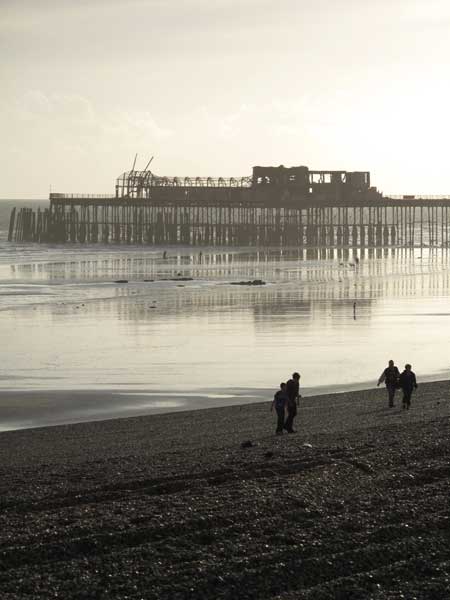Simon Calder: The end of the pier, but is it the end of the road?
The man who pays his way

Your support helps us to tell the story
From reproductive rights to climate change to Big Tech, The Independent is on the ground when the story is developing. Whether it's investigating the financials of Elon Musk's pro-Trump PAC or producing our latest documentary, 'The A Word', which shines a light on the American women fighting for reproductive rights, we know how important it is to parse out the facts from the messaging.
At such a critical moment in US history, we need reporters on the ground. Your donation allows us to keep sending journalists to speak to both sides of the story.
The Independent is trusted by Americans across the entire political spectrum. And unlike many other quality news outlets, we choose not to lock Americans out of our reporting and analysis with paywalls. We believe quality journalism should be available to everyone, paid for by those who can afford it.
Your support makes all the difference.Oh dear: no pier. Continuing the familiar 21st-century tradition established by Hunstanton (2002), Brighton (2003), Southend (2005) and Weston-super-Mare (2008), this week Hastings became the latest English seaside resort to see its pier, and some of its heritage, go up in flames.
A fire in the early hours of Tuesday morning destroyed much of the superstructure of this Victorian masterpiece. By the time I arrived on the Sussex coast on Wednesday, the still-smouldering remains had become – at least temporarily – a tourist attraction, drawing dozens of sightseers. As so often happens in travel, tragedy proves magnetic, at least fleetingly.
"Local people were in tears on the night of the fire," said Jeremy Birch, the leader of Hastings Council. "It had been part of their lives and had a place in everybody's heart."
Even away from the forlorn spectacle of the pier, the air was heavy with the bitter tang of smoke. "Police – Accident" warned a blue sign by the barrier keeping the mourners at bay.
A funeral pyre? Within hours, a Facebook site called "RIP Hastings Pier" was mourning the town's loss. You can visualise the municipal obituary already: the end of the pier means the end of the road for the resort at the end of the A21.
Thankfully for both the town and the traveller, Hastings' hopes and dreams did not vanish into that unnaturally bright night sky. The pier may yet be resurrected. Jeremy Birch says a structural survey will show whether or not the ironwork can be saved and built upon: "It's very important to us emotionally." Let's hope he's right: from as close as you can get to the pier, the spindly supports look fragile.
Yet in terms of tourist attractions you might wish to visit, the fire was irrelevant: the 19th-century structure had closed to the public four years ago because of safety fears. So on Monday you could not visit this derelict Victorian masterpiece, and on Tuesday you could not visit this fire-damaged Victorian masterpiece.
Happily, Hastings possesses many more dimensions than a former finger of fun pointing pathetically towards Picardy. As the East Sussex fire brigade was clearing up on Wednesday afternoon, I was wandering through the town's latest boutique B&B.
The Old Rectory on All Saints Street follows the course set by Swan House, creating seductive spaces within a historic setting. The rooms have names, not numbers: "Crown" is a study in indulgence, with furniture that seems to want to cosset you. Downstairs, the finishing touches were being made to the dining room, whose walls are decorated with a hand-painted rhapsody of spring, in blue.
The paint was still wet. I didn't stay to watch it dry: perhaps contrary to popular belief, there are more interesting ways to spend your time in Hastings. Its fine medieval buildings were created off the back of its status as a prosperous fishing town – a huddle of "net huts", blackened by tar and time, still stands on the seashore. (Rock a Nore is the venue to taste fresh or smoked seafood, with locally caught plaice the top choice this week.)
Smuggling used to be a highly profitable sideline, but when Customs & Excise tolerance ran out, tourism took over. See Travel Agenda, below, for some ideas.
The problem for Hastings is that it is so jolly difficult to reach: trains take longer to get from central London to Hastings than to more celebrated tourist spots that are much further away, such as Bath, Bournemouth and even Lille. Yet the town that starts where the A21 ends (close to the pier, incidentally) is, as the guidebooks say, "worth a detour". Just as well, really, because Hastings is on the way to nowhere.
Signs of the seaside
"Rotting from the ground up," was the helpful pronouncement by Dr Kim Howells about some English seaside resorts. At the time, he was tourism minister. He declined to tell me the specific places he had in mind, but towns such as Hastings need to take care that the messages they give out do not add weight to his view.
Nothing wrong with the admonition from Karl's Bar: "Don't go to our rivals for high prices & bad service – come here instead". But on my last visit, I was surprised to see the seafront tourist information kiosk promoting a deal from Southern Railway promising to help you escape Hastings and get into London for a fiver.
The town shows some marketing savvy, though: it claims to be "1066 Country", even though the Norman invasion 944 years ago this week took place 10 miles west at Pevensey Bay, while William the Conqueror defeated the Saxons six miles inland at the location now known as Battle. But Hastings owns 1066 and all that valuable tourism collateral.
Join our commenting forum
Join thought-provoking conversations, follow other Independent readers and see their replies
Comments